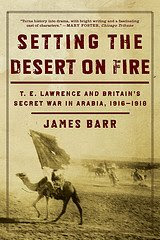Another interesting review, this time on Barnes and Noble's website. It usefully draws attention to a book I had not heard about before: Polly Mohs's Military Intelligence and the Arab Revolt, published by Routledge in October last year.
According to the blurb (from Amazon) Mohs argues that "Modern intelligence techniques such as Sigint, Imint [aerial reconnaissance to you and me] and Humint were incorporated into strategic planning with greater expertise and consistency in Arabia than in any other theatre during the war, and their deployment as tactical support for the Arab forces was decisive."
Although the British overplayed the remoteness of the Hijaz, the jagged desert landscape where the revolt played out, there is no doubt that they had little to go by. A few brave explorers - most famously Richard Burton - had criss-crossed the area on foot before the war. The most recent was a young army officer named AJB Wavell who, like Burton, disguised himself as a Muslim to enter Mecca in 1909. Wavell was killed in East Africa during the First World War, before he might have been called in by the Arab Bureau to offer any assistance. The British were thus bereft of signficant first hand experience of the area. When I was doing my research, I was amused to find, in the corner of one British military map, this caveat: "This map is a collection of sketches by Egyptian pilgrimage officers and members of the Sherif's forces. An attempt has been made to control it by native information, but without success."
Until the advent of Google mapping and Google Earth a couple of years ago, maps of Saudi Arabia remained in short supply, and the one I did purchase before I visited in 2005 had few of the obscure places marked, like Wadi Safra and Hamra (where TE Lawrence first met Feisal), that I was keen to go and see. I found myself relying on copies of the same maps that the British officers had used 90 years before to guide their way.
Shortage breeds ingenuity, and the government in London's reluctance to commit forces, and the vastness of the Hijaz both encouraged the British locally to use aerial reconnaissance to make up by accurate information what they felt the Arabs lacked in numbers, weapons, organisation and tactics. After some delaying a flight was sent to Rabigh on the Arabian coast. Lawrence initially in fact dismissed the value of aerial photography - he probably saw it as a threat to his own ventures into the interior, but those reservations did not last long.
I see that an article I read some time ago, about the work of the Royal Flying Corps in the Arab Revolt, has now been joined by the text and maps from Thomas Henderson's first hand account of operations, which is kept in the Imperial War Museum in London. Both are well worth reading.
The British also successfully intercepted Turkish wireless communications. It was not until someway through my research that I discovered that a phrase dotting British telegrams concerning enemy plans - "from an absolutely reliable source" - was shorthand code for information gained from this traffic.
Anyway, since I did not give much specific thought to the role of intelligence in Setting the Desert on Fire, I am looking forward to reading Polly Mohs's book.
Wednesday, April 23, 2008
Aerial reconnaissance in the Arab revolt
Monday, April 21, 2008
Subscribe to:
Comments (Atom)


